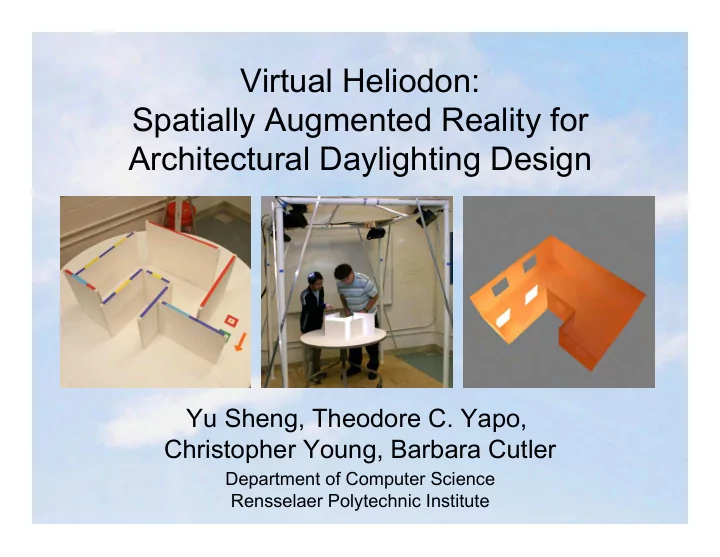

Virtual Heliodon: Spatially Augmented Reality for Architectural Daylighting Design Yu Sheng, Theodore C. Yapo, Christopher Young, Barbara Cutler Department of Computer Science Rensselaer Polytechnic Institute
Natural Light vs. Electric Light Lighting accounts for 22% of US electricity consumption
• 380 lux • 320 lux • 1030 lux • 880 lux Lights off, no blinds Lights off, blinds open • 620 lux • 110 lux • 620 lux • 180 lux Lights off, blinds closed Lights on, blinds closed 500-1000 lux recommended for reading direct sunlight ≈ 100,000 lux
Architectural Daylighting Design: The use of windows and reflective surfaces to allow natural light from the sun and sky to provide effective and interesting internal illumination. 8 am 10 am 12 pm 2 pm 4 pm Jun 21 Mar/Sep 21 Dec 21 Residential design proposal by Mark Cabrinha
Analysis with Traditional Heliodon Shadows and light penetration can be observed on small scale physical model
Related Work: • Daylighting Design – Radiance, Greg Ward Larson • Virtual / Augmented Reality – CAVE (Cruz-Neira et al., 1992) – Interior Architectural design (Mackie et al., 2004, Dunston et.al, 2007) • Spatially Augmented Reality – Office of the future (Raskar et al., 1998) – Everywhere Display (Underkoffler et al., 1999) – Shader Lamps (Raskar et al., 2001) – Automatically-calibrated cameras and projectors (Raskar et al., 2001) – Multi-planar display (Ashdown et al., 2004) – Shadows and occlusions (Audet & Cooperstock, 2007)
Table-top Daylighting Design camera to detect geometry 4 projectors to display solution design sketched with foam-core walls
Algorithms and Implementation • Hybrid Rendering Algorithm • Model Construction • Camera & Projector Calibration • Primitive Detection • Multi-Projector Display
Algorithms and Implementation • Hybrid Rendering Algorithm • Model Construction • Camera & Projector Calibration • Primitive Detection • Multi-Projector Display
Radiosity • Global illumination algorithm – Diffuse surfaces • Why not radiosity alone? – Low resolution mesh → inaccurate shadows • Why do we need “hard shadows”? Radiosity/Shadow Volumes Radiosity – More realistic – More intuition about scene geometry & lighting
Interactive Global Illumination: Hybrid Radiosity/Shadow Volumes 1. Radiosity 3. Indirect=1-2 2. First bounce 4. Shadow volumes 5. Final=3+4 Exploit smoothness in indirect illumination Efficiently compute direct illumination
Algorithms and Implementation • Hybrid Rendering Algorithm • Model Construction • Camera & Projector Calibration • Primitive Detection • Multi-Projector Display
Sketch Interpretation red: exterior wall w/ window green: exterior wall yellow: interior wall blue north arrow software automatically constructs closed polygonal model for simulation
Algorithms and Implementation • Hybrid Rendering Algorithm • Model Construction • Camera & Projector Calibration • Primitive Detection • Multi-Projector Display
Camera Calibration • Using Zhang’s algorithm [Zhang 1999] to estimate the intrinsic parameters of camera – Calibration target consisting of 212 black and white corner marks on a white background – 40 pictures taken at different orientations
Projector Calibration • Tsai’s algorithm [Tsai 1987] – Uniformly spaced horizontal planes Projector calibration Common coordinate system
Algorithms and Implementation • Hybrid Rendering Algorithm • Model Construction • Camera & Projector Calibration • Primitive Detection • Multi-Projector Display
Primitive Detection • Color classification • RANSAC: fit line to edges • 2D 3D, projection matrix Projection Geometry Reconstructed Scene Physical Sketch � Edge Detection �
Watertight Mesh for Simulation (model interior) Detected geometry Projection surfaces “Fill-in” geometry “Extra” physical geometry
Algorithms and Implementation • Hybrid Rendering Algorithm • Model Construction • Camera & Projector Calibration • Primitive Detection • Multi-Projector Display
Multi-Projector Display • Radiange adjustment • Intensity blending – Smooths transitions between projectors – Each vertex in the mesh has a “best projector” for display
Results • For a geometry with 1500 triangles – 0.6 seconds to relight for changing time / day, north orientation, etc. – 6-7 seconds to generate the projection images for a new geometry • Image processing: 0.05 seconds • Remeshing: 2.5 seconds • Form factor computation: 3 seconds
Traditional Heliodon Virtual Heliodon • Ceiling has been • Must peer in the removed allowing easy windows, but avoid viewing blocking the “sun” • Less precision is • Close approximations needed in joining walls of all materials must be used in model • Materials are specified construction digitally and do not require a physical • Model construction is sample of the material tedious • Initial construction and edits are fast and easy
Ongoing and Future Work • Formal user studies • Robust image processing, e.g., ignore users’ hands • Table surfaces, curved walls, sloped ceilings • Consider dynamic range of projectors • Complex fenestration (window) materials • Compensate for secondary scattering of projected imagery
Light-Redirecting Materials Prismatic panels available in late 1800’s, but lost popularity when electric lighting was introduced plain glass prismatic
Secondary Scattering Compensation Desired illumination Naïve projection Compensated Compensated projection
Thanks! • Collaborators: Marilyne Andersen Mark Cabrinha Melissa Schroyer • RPI Computer Vision Research Group • IBM & NSF
Recommend
More recommend